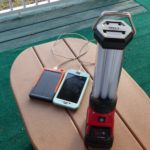by Winding Pathways | May 15, 2025 | Preparedness, Ruminations
*Apologies to Ben Franklin*
It’s funny how quotes get attributed to people. Franklin might not have actually said the quote above, but he did have the right idea with his quote: in the 1737 Poor Richard’s Almanack: “A penny saved is two pence clear.” When you save something today, it likely will grow in worth over time.
We are on the far side of age 75 and enjoying financial security that has resulted from a lifetime of careful spending, good advice, and a bit of luck. A penny saved here and there added up.
We’re not financial experts so this is just how a lifetime of money management enabled us to emerge into good money health despite years of lean income.
Over many years of talking with people facing financial stress we often hear them say, “I need to find a job that pays better.” Well, you might not need to do that. You simply need to spend less and perhaps live in a more affordable geographic location. Dr. Laurie Santos, professor at Yale University, hosts a series on the Science of Well Being. She also hosts a six-week course, the Science of Well-Being for Teens. Participants look closely at their lifestyles and where they spend time and money that drain them, causing them to think they need more. Often it is not true. It’s a great course to take online.
Our Background
We worked in the nonprofit sector, which provided slim salaries and sparse benefits. We liked what we did so never felt compelled to change jobs for better pay. Rather than seek higher pay we used what money we had efficiently.
Financial Philosophy
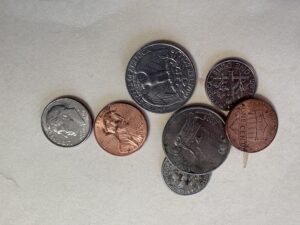
A Penny Saved is a Penny Earned
Our basic financial philosophy is that however much money a person earns, if he/she spends a little less and consistently invests the difference, financial health increases. Of course, that was partly back in the day when financial institutions gave better interest return on money customers deposited.
Decades Long Strategy
Here’s what we’ve done for over a half century to be financially secure.
- Avoided compulsive, ego spending. Keeping up with the Joneses costs money.
- Developed a long-term relationship with our bank and brokerage as partners. Their advice is free.
- Avoided paying rent and borrowing money. Yup, we drove old cars we could pay cash for and regularly put money in the bank. This earned us interest and avoided loan interest. Then, when we needed to buy a car, we withdrew money and paid cash. We rented apartments briefly but invested in a house purchase. Because we live frugally, we were able to pay off a mortgage early. Now our housing costs are utilities, taxes, and maintenance. No monthly rent or mortgage! It’s a pay-as-we-go philosophy. Granted, we did not “enjoy” some of the exotic trips or coolest stuff and we are better off for it.
- Avoided voluntary taxes. People complain they don’t want to pay taxes. (Benefits exist to paying legitimate taxes) Then, what do they do? Some buy tobacco, alcohol, and gamble.
By doing so, they pay self-imposed high taxes and often end up with health issues. We’ve never smoked, don’t gamble, and enjoy a beer or a sip of wine occasionally. A pack of cigarettes in Iowa costs about $9. If we each smoked two packs a day, our daily cost would be $36. That’s over $13,000 a year. If we’d done this for our 50-year marriage we’d have spent far more on tobacco than to buy our home.
- Embraced life cycle cost. For example, it’s common for the least expensive refrigerator to consume the most electricity. Life cycle cost means figuring out what an object will cost during its likely lifespan. Usually paying slightly more upfront for a well-made, efficient device saves chunks of money over time. Energy efficiency saves money! BTW, ditch the inefficient refrigerator or freezer you’ve held on to. Recycle it. Likely you don’t need all the extra stored food. Your electric bill will go down and you have more space in your home.
- Embraced inexpensive recreation. People often carefully calculate the cost for business and home functional items, then spend ridiculously on recreation.
Hobbies
Rich’s hobbies are reading (library books are free), walking, birding, and fishing. He also scrounges and crafts items like bird feeders.
Fishing’s a good example. It can be expensive but doesn’t have to be. A cheap rod and reel costs about 30 bucks and won’t last long. A better one costs about $100 and is durable and efficient, but the very best is around $500. Sticking with the $100 model is the most cost efficient…..and he catches fish from an ancient rowboat purchased at a garage sale. In contrast, an expensive powerboat and electronics need insurance, storage, maintenance, and fuel. Not needed for catching fish.
- We love gardening, which helps lower food costs. Even a small patio can support vegetables you may enjoy.
- Avoid being nickel and dimed to death. It sounds cheap. Only eight dollars a month for a streaming service. $96 a year. Multiply that by six streaming services and that $96 a month costs close to $576 a year. All sorts of other things that seem cheap per month put a constant drain on finances. A few bucks here. A few bucks there. They add up!
- Use our credit card carefully and always pay off the balance on time to avoid interest costs.
Final Words
The upshot is, most people do NOT need to earn more money, they need to learn to use what they have wisely.
We spend carefully yet live richly and have avoided the terror of a heavy debt burden. Our financial strategy has led us in a good direction and we believe it may help others to achieve the same result.
by Winding Pathways | Sep 12, 2024 | Preparedness
Make it Easier on Yourself
We’ve written this before and will write it again: Simple disaster preparation makes sense.
A few days after Hurricane Beryl knocked out electricity for thousands of homes in the Houston area, we turned on the evening news. A reporter interviewed a family who had evacuated to an emergency shelter. Their home had not been damaged but they had no power.
“We could handle the heat but we had no food or water, so we came to the shelter,” one of the victims said.
How sad. Simple preparation could have made their lives easier. They wouldn’t have had to go to a shelter for food and water or to charge their phones.
We encourage everyone to store at least two weeks of food and water. By then the electric company is likely to have restored power. Remember, ATMs need electricity to work. Have some cash handy for emergencies.
Here’s what we keep on hand:
- 25 gallons of water in five five-gallon food-grade containers. Clean milk jugs work well for storing water. This is for drinking and cooking – not bathing.
- Sealed containers of food we bought from My Patriot Supply. It has a 25-year shelf life. These provide two weeks of food for the two of us. Many other companies sell long-term storage foods online.
- A moderate supply of canned and dried food, including flour, beans, rice, and nuts. A hand-operated can opener. We’re constantly using and replacing these foods but what we routinely have on hand would last at least a week. We keep minimal food in our freezer so a power loss wouldn’t greatly impact us.
- A camping stove and plenty of fuel that’s stored in the garage.
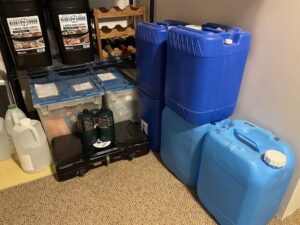
Keep supplies on hand.
None of these items needs electricity for storage. A power outage knocks out refrigerators, so any cold or frozen food is vulnerable. If our electricity went out, we’d eat these first before they spoil.
If the couple in Houston had stored a couple of weeks of food that doesn’t need refrigeration and a camp stove and fuel they could have stayed in their home until the power came back on. Having some nonperishable food and water in storage is a solid emergency strategy.
by Winding Pathways | Oct 12, 2023 | (Sub)Urban Homesteading, Preparedness
What To Do When No Room At the Inn?
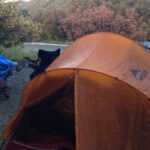
Even bivouac camping can be comfortable.
Basic bivouac camping gear saved our night as we drove along a rainy Ohio Interstate.
We were returning to Iowa from a business trip in New Jersey. The 1000-mile trip is too far for us to make in a day so we normally plan to overnight in a comfortable motel in Ohio or Indiana.
On this recent trip, we didn’t make a reservation in advance, so Marion called motels ahead of us as Rich drove through pelting rain. Bad news. They were all booked for the night.
Bivouac Camping Saved Us!
Our basic bivouac camping gear saved us. Marion spotted West Branch State Park on the map. Not far ahead of us and near the Interstate, we exited just as the downpour subsided. Soon we enjoyed a hot dinner inside a restaurant near our tent.

Lightweight camping gear stashed on the sides of the car.
Although we weren’t on a camping trip, we always carry basic bivouac camping gear just in case we run into a situation like our recent one. Modern backpacking gear is lightweight, compact, and effective. It’s essential for a long trail trek but also takes up little space in the car and comes in handy should camping be necessary.
Here’s what we always slip into the car:
- Small nylon tent and ground cloth. Sturdy pegs (spikes or gutter nails are sturdy, don’t bend and so are useful to hold cords to tie a tent down.)
- Lightweight foam mattresses and sleeping bags.
- Folding chairs.
- Cooking and food gear that includes:
* Tiny featherweight butane stove and fuel bottle
* A few backpacking-type meals
* Basic utensils
* Matches! (Remember these!)
Cooking gear and dried meals fit in a small cardboard box and it’s easy to stash the other gear here and there in the car.
-
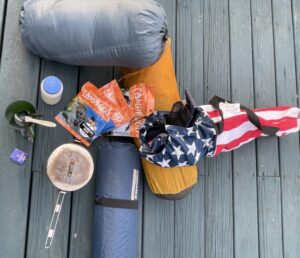
-
Looks like a lot! It’s not!
-

-
Essentials in box
The morning after our unplanned campout we woke well-rested, sipped instant coffee, packed up, found a breakfast cafe, and were soon back on the Interstate heading home.
A Note on Dried Food
Years ago, dried camping food was tolerable but hardly tasty. That’s changed. Modern foods are delicious. We keep two weeks of dried meals in our preparedness bin at home. Should we be impacted by a natural disaster we’d break out our camping stove and enjoy tasty meals. Although this food lasts for years we occasionally eat a few meals at home, on planned camping trips, and during emergencies. Then we restock with fresh meals. We have previously written about preparedness on our blogs.
by Winding Pathways | Jan 19, 2023 | (Sub)Urban Homesteading, Energy Efficiency, Home Improvements, Preparedness
Power outages. They happen in an instant. Most are only a flicker but some can last for hours when the wind’s whistling and the temperature’s dropping outside. Or in summer when the heat rises.
What’s the best thing to do in power outages? Well, it’s best to anticipate it and be ready by having a few things ready to pull out of the closet when the lights go out. Here’s a short list:
Cooking and Food:
- Propane or gas camping stove with plenty of fuel stored away from the main residence. (i.e. in a stand-alone garage) If you live in an apartment or condominium have less volatile fuel options ready.
- A few days of nonperishable or dehydrated camping food.
- Several gallons of water stored where it won’t freeze.
Power Outages and Light & Heat:
Electronics:
- Cell phones and other electronic batteries drain quickly. A backup power source and solar-powered phone charger keep the phone working.
One More Important Item:
- In a widespread power failure credit and debit cards don’t work. Cash always does. Keep some cash in small bills to use during emergencies.
Many other items readily available in case of emergencies help keep life comfortable. Read about them on our other blogs. The list above covers only the most basic and sometimes overlooked, emergency items to keep on hand. Get ready now for power outages.
-

-
We found the meals tasty and filling.
-
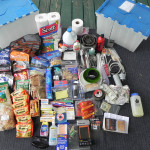
-
emergency food
-
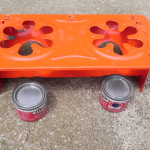
-
This two-burner Sterno keeps food warm but is less useful for cooking. Great for old style fondue parties!
by Marion Patterson | Jun 2, 2022 | Chickens, Garden/Yard, Geology/Weather, Hoover's Hatchery, Preparedness, Reflections/Profiles, Travel/Columns
Coming up to a year from the last post on the features we wrote for the Cedar Rapids Gazette, here is an updated list for the second half of 2021 and the first half (almost) of 2022. These features are in addition to our regular work with Hoover’s Hatchery blogs and FB Live and our own blogs for Winding Pathways.
May 8, 2022. Splish Splash! Whitewater Kayaking in Iowa. (No link to date)
April 22, 2022. Finding America On Roadways East.
April 13, 2022. Muscle Over motor When Boating.
March 21, 2022. Rockhounding.
January 30, 2022. Backpacking Bonus. (8B of GZ. No link to date) Available Green Gazette.
January 24, 2022. Distinctive Religious Structures.
January 16, 2022. Hiking Wild Areas. (no link to date) Available Green Gazette.
December, 2021. Country Schools. (no link to date) Available Green Gazette
November 15, 2021. Making a (Mini) Pitch for Soccer.
October 6, 2021. A visit with Midwest’s Pioneering Authors.
September 8, 2021. Taking a Slow Boat to Cassville.
September 6, 2021. Camping in Iowa’s Trout Country & Decorah’s Celebrities.
August 4, 2021. Parking While Headed East. And Solar Panels at Peoples.
by Winding Pathways | May 26, 2022 | (Sub)Urban Homesteading, Garden/Yard, Garden/Yard, Preparedness
Good Friday Tradition
On a cold April morning, we planted a row of potatoes at Winding Pathways. This plant has made an amazing long journey to reach our yard.
Potatoes are native to South and Central America and were cultivated by native people long before Columbus. Early Spanish explorers realized this humble American plant produces an enormous amount of food that’s easy to store. They brought potato sets back to Spain, and eventually, the plant was cultivated throughout Europe.
-

-
Sweet potatoes are a healthy vegetable.
-

-
Potatoes are hardy and plentiful.
Productive Crop
Potatoes produce more human food per square foot than wheat, rice, corn, or nearly any other crop, so crowded Ireland embraced the plant. Potatoes thrived in Irish soil and were so productive they enabled the human population to flourish. Unfortunately, the entire crop was of just one or two varieties. Disaster hit. Between 1855 and 1859 blight killed most of the crop, which lacked resistance to the disease. It caused massive starvation and spurred huge immigration to the United States.
Early Europeans who colonized North America brought potatoes to plant in the New World. So, an American plant crossed the Atlantic Ocean twice in its long journey.
Vandals and Hawkeyes
We both hold degrees from the University of Idaho. It’s the potato state, and the plant loves the light volcanic soil along the Snake River in the southern part of the state. Iowa, where we live, is the corn state, but humble potatoes do well in our garden.
We buy seed potatoes in early spring, cut and cure them, and plant them in early April. They don’t expect much from us, and by mid-summer we carefully hand dig delicious new potatoes. Later, when the tops die back, we dig and cure a bushel, or so, for winter storage.
Expert Resource at Hand
We hedge our bets by planting a few potato varieties, and this year we’re fortunate to have a potato expert move to Cedar Rapids. Jean Contina earned his doctorate degree from the University of Idaho studying potato diseases. He’s a fellow Vandal! We’ll seek his advice on how to maximize our crop.
-
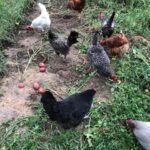
-
Chickens don’t seem to bother the potatoes.
-

-
Beautifully presented dinner.
Inexpensive. Why Grow Them?
Store-bought potatoes are one of the least expensive foods. So why grow them?
We have two reasons. First, anything we grow seems more delicious than its store-bought counterpart. It may be our imagination but it is true. Second, they are an easy crop to grow and store well all winter without the need to can or freeze them. Having potatoes stored in a cool dark room in our house gives us a bit of food security in a crazy world.







